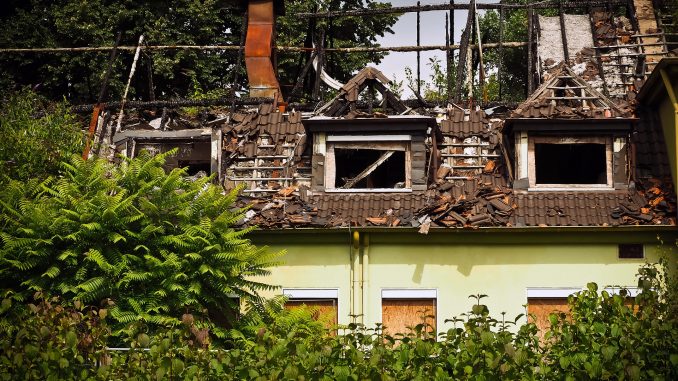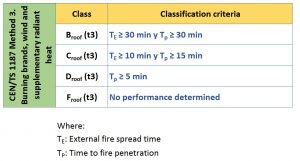
Introduction
In this third post of the thematic series on roofs exposed to an external fire, I am going to explain you the third method of test included in the technical specification CEN/TS 1187. This method combines the burning brands, wind and supplementary radiante heat.
Test method 3. Burning brands, wind and supplementary radiant heat
This test consists on apply to the specimens to the combined action of the brands wind and radiant heat for 30 minutes to evaluate their fire behaviour based on the fire spread, fire penetration, openings and the damage produced by the fire.
Two specimens shall be tested with a dimensions of (3 x 1,2) m and they shall be representative of the end use application. For each test, 2 brands from wood fibreboard are required made of 4 pieces of (55 x 16 x 25) mm nailed together to form a grid of (55 x 32) mm. Before use, the brands should be soaked with n-heptane.
The air velocity required to simulate the will have a velocity of 3 m/s. The radiant heat will be achieved thanks to the action of a radiant panel located 500 mm from the surface of the specimen. The distribution of the heat flux on the specimen will be in the centre of 12,5 kW/m2 and of 10 kW/m2 on the major axes.
The pitch of the specimen during the test will not always be the same and will depend on the end use application. Therefore, the roofs intended to be installed with pitches up to 10°, will be tested at 5°. If the roofs will be installed with a pitch greater than 10°, the pitch of the specimen during the test will be 30°.
As in the previous fire tests for roofs, this test method offers a range of standard supporting decks.
- Wooden continuous deck with a gap not exceeding 0,5 mm between the planks. The field of application will be for any wooden continuous deck with a minimum thickness of 12 mm and with gaps not exceeding 0,5 mm and any non-combustible continuous deck with a minimum thickness of 10 mm.
- Wood particle board deck with gaps of 5,0 mm between the planks. The field of application will be for any wooden continuous deck, any deck made from wooden planks with plain edges and any non-combustible deck with gaps not exceeding 0,5 mm.
- Calcium silicate board. The field of application will be for any non-combustible continuous deck with a minimum thickness of 10 mm.
- Trapezoidal profiled steel deck. The field of application will be for any profiled and non-perforated steel deck and any non-combustible continuous deck with a minimum thickness of 10 mm.
Concerning to position of the joints, we could find two types of specimens.
- Type 1: Single central joint in the top layer parallel to the roof pitch. Single joint in the top layer to the roof pitch, under position of left brand. Single joint in layer next to top layer under position of right brand parallel to the roof pitch. Single joint in insulation under position of left brand, parallel to the roof pitch.
- Type 2: Single joint in the top layer parallel to the roof pitch, under position of right brand. Single joint in layer next to insulation parallel to the roof pitch, under position of the left brand.
The duration of the test is 30 min. Nevertheless, the tests will be terminated before 30 min if occur the following events:
- Fire spreads on the underside of the specimen following penetration.
- There is a risk to safety of personnel or impeding damage to equipment.
Classification system
As I explained in the first post of this thematic series, a classification standard is necessary to comply with national legislations. The standard EN 13501-5 will be applicable and offers for the test method 3, four possible classifications, Broof (t3), Croof (t3), Droof (t3) and Froof (t3). The classification criteria for the previous classes are shown below.

Bibliography
CEN/TS 1187. Test methods for roofs exposed to external fire.
EN 13501-5. Fire classification of construction products and building elements – Part 5: Classification using data from external fire exposure to roofs tests